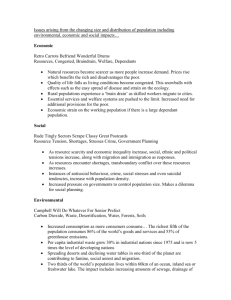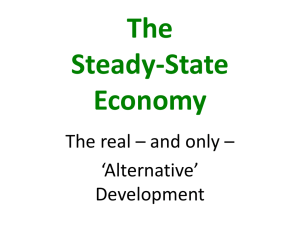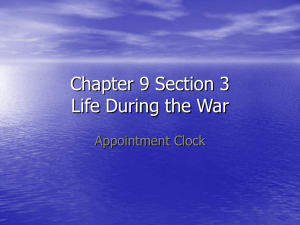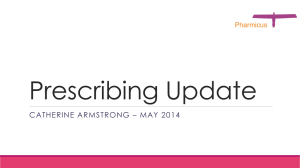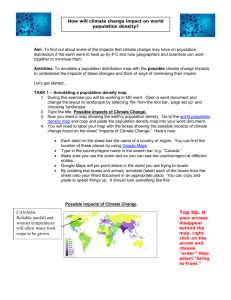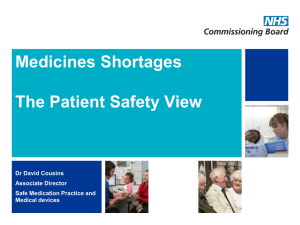Group Project – Food for Thought – Final Report
advertisement
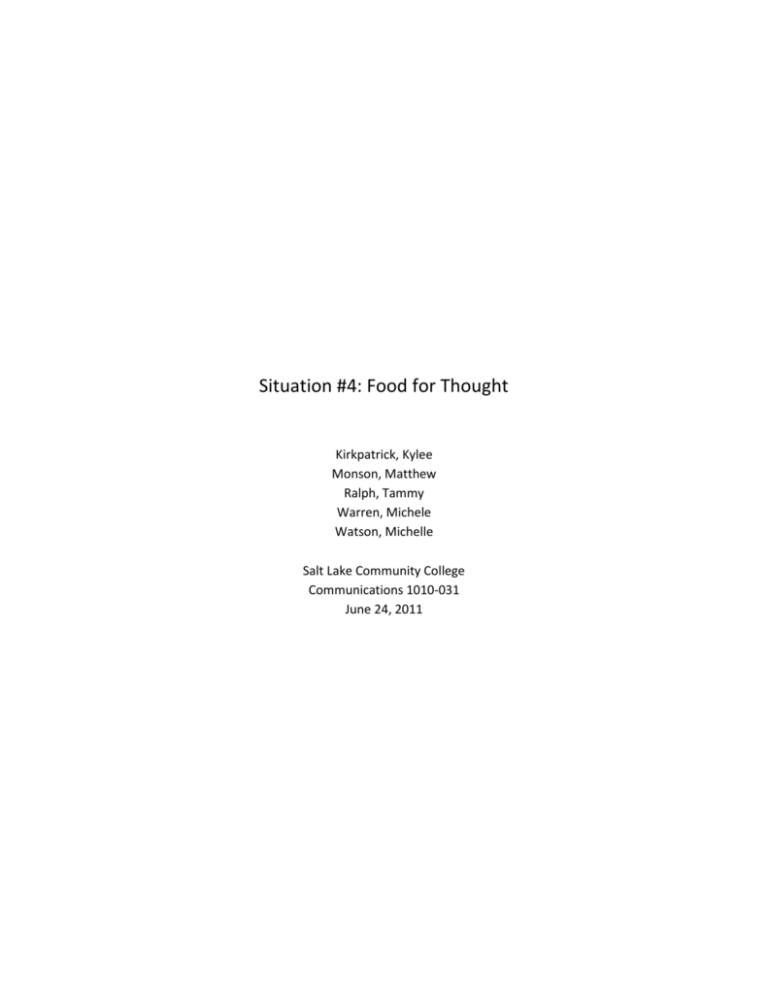
Situation #4: Food for Thought Kirkpatrick, Kylee Monson, Matthew Ralph, Tammy Warren, Michele Watson, Michelle Salt Lake Community College Communications 1010-031 June 24, 2011 Situation #4: Food for Thought Overview In the current economic climate, local food banks, as well as other dispensers of donated goods, are chronically running short of important items. These dispensaries typically see a surge in donations during the holiday season, but these surges are generally short lived. The increased number of people seeking assistance, coupled with an overall decline in donations due to a shrinking donor base, has resulted in a deepening of scarcity cycles in various locations. This creates additional stress on populations that are served by the dispensaries and makes the management and distribution of the goods more difficult. In situation four, the local food bank is experiencing both a short term, and chronic shortage in food goods. With the issue of acute versus chronic shortages, mimicking the holiday donation cycle is doing little to address the overall problem. A solution is necessary that addresses both the chronic and acute issues of food shortages. Our group created an organizational model that may be used by small groups of 5-12 people who have limited time and resources to address shortages with many situations. This model seeks to create relationships between groups and individuals that can deal with chronic shortages on long term basis. Short-term solutions will occur naturally as a result of pursuing these relationships. Methods Our working group used Dewey’s Reflective-Thinking sequence as a guide for analyzing and addressing the problem of chronic shortages. The purpose of this sequence is to help groups and individuals define and analyze a problem, establish criteria for the possible solutions, and to consider, implement, and follow up on these solutions. The following is a detailed description of how our working group applied the reflective-thinking sequence to create an organizational model which can be used to address chronic and acute shortages. Step 1: Define the Problem In order to define the problem, we put it into a clear, concise, single sentence question: “What is the best way we, as students with limited time and budgets, can help the food bank increase its current stock and reduce chronic and acute shortages?” Step 2: Analyze the Problem Each member of the group was assigned this step individually at our initial preparation meeting. We came together in our planning meeting and presented what we had found. The following are the aspects that were identified and discussed by each member: 1. Characteristics 2 Comm1010-031 Situation #4: Food for Thought Our group found that running out of important food items was a problem for the following reasons: Shortages create additional stress on the populations that are served by local food banks They create management irregularities which make the distribution of pantry items and volunteer coordination difficult Long term shortages can create a competitive environment for the populations that are supplementing their resources with donated food items Continued shortages can threaten permanent closure of local food banks We identified the following aspects of the problem: A sharp decline in donations due to a shrinking donor base Past donors are now seeking relief from food banks and can no longer donate Elderly and disabled populations who rely on regular support from area food banks are forced into insecurity A shortage of new donor possibilities to meet the increased demand A lack of creative problem solving, networking, and innovation to meet the unusually high demands for food It is believed that the future effects of chronic shortages may include, but are not limited to the following: 2. Stakeholders A deepening of the scarcity cycle Increased numbers of marginalized workers and families Increase in the homeless, unemployed, and crimes related to scarcity The following are the groups that we identified as being affected by the problem, and some of the ways they are affected. Elderly and disabled o Will have to choose between nutrition, medications, and shelter o Have limited physical, mental, or financial resources for identifying alternate sources of nutrition Newly unemployed, underemployed o Temporary situations can become permanent without assistance o There is a potential for long term dependence on charitable sources when the temporary needs are not met. Homeless adults and youth o Subsistence and at-risk populations suffer from lack of other resources due to their socio-economic status o Increased likelihood of crimes related to scarcity 3 Comm1010-031 Situation #4: Food for Thought o Incarceration as a means of survival Food bank staff, charitable workers, volunteers, and charitable networks o Loss of diversity in charitably networks due to closures o Tradition of giving and volunteering stunted o Burnout, stress, cynicism becomes more prevalent in larger culture o Food bank closures lead to more dependency on other charitable networks Step 3: Establish Criteria for a Solution In our planning meeting, we set the criteria for judging our possible solutions. The following is the criteria we decided to use. 1. 2. 3. 4. 5. 6. 7. Is duplicable by other groups and can be applied to other shortages Involves a range of different community groups and individuals Can be accomplished with a limited time investment Creates a long term relationship and solution to address chronic shortages Involves networking with existing groups and resources Adheres to SLCC policy Has little to no cost to implement Step 4: Consider Possible Solutions to the Problem Our group brainstormed possible solutions to the problem. In our planning meeting each person presented the solutions that they had come to as part of their pre-meeting tasks. The possible solutions: Food drive at a SLCC campus Attaching a food drive to some type of existing event Asking for food donations door to door Cold calling corporations to ask for donations Setting up bins in grocery stores to collect donations from shoppers Warehouse theft Raising money through bake sales, car washes, etc. Step 5: Decide on a Solution We considered the solutions as a group by using our criteria table (Refer to Appendix III). Some solutions were ruled out immediately, such as cold calling, and warehouse theft, others seemed more promising. A food drive held at one of the Salt Lake Community College campuses seemed like an obvious solution. It was something that was easily repeated by other groups and there were no extensive monetary costs. We realized, however, that it would not have a long term effect. 4 Comm1010-031 Situation #4: Food for Thought We then considered a door-to-door donation drive. This option would involve the community and could be accomplished in our limited time investment criteria. We did not choose this plan because it was not a long term solution, and may have hidden transportation costs. The next solution was to hold a food drive in conjunction with a local event. This option was replicable, involved the community, and, if the tasks were divided effectively, would not require more than 5-10 hours per volunteer. Holding a food drive in this way would bring the needs of the local food bank to the attention of a wider audience, and used networking in a way that could create relationships with other individuals and groups that could be incorporated into future fundraising projects. After deciding on this solution, we analyzed our problem from a broader perspective. The approach could be applied to a variety of situations over long periods of time to help the food banks remain stocked year round. We created an organizational model that could be applied to a variety of different situations (Refer to Appendix I) Step 6: Implement the Solution In our second meeting we determined how the solution could be applied to a specific situation to resolve our presented problem. The following is an example of using our situation with the local Arts Festival: Stage 1: The main coordinator will gather all participants and assign roles Stage 2: The model group will discuss tasks related to attaching a food drive to the local arts festival Stage 3: Each model group member will fulfill their individual roles. Specifically, Main coordinator follows up on the progress of each model group member. Beneficiary Liaison contacts the local food bank to discuss specific needs. Event Liaison contacts the local arts festival to arrange holding the food drive at the event. Volunteer Liaison seeks and begins organizing volunteers and creating phone trees. Media and Advertising liaison identifies free advertising sources and prepares advertising materials for circulation. Stage 4: Weekly meetings are held in which problem solving, scheduling, task assignment, and planning occur. At this stage, the featured tasks are for the beneficiary and event liaisons. They will inform the other members of what is required and those members will organize their roles tasks accordingly. 5 Comm1010-031 Situation #4: Food for Thought Stage 5: Weekly meetings are held in which problem solving, scheduling, task assignment, and planning occur. The beneficiary and event liaisons will inform the other members of what is required and those members will organize their roles and tasks accordingly. Stage 5: Site will be set up and goods gathered at event. The logistics coordinator will ensure that any issues are resolved on-site. Stage 6: Break down of on-site supplies and the delivery of the donated items will be completed. The logistics coordinator will again ensure that on-site issues are resolved. Stage 7: There will be a project review meeting where the model group will review any improvements that can be made to the planning for their next project. Step 7: Follow Up on the Solution As a follow up to our solution our team asked ourselves some key questions and determined possible solutions. Is there too much dependence on volunteers to successfully complete the group goals? Recruiting volunteers early to staff projects is vital for the success of volunteer based solutions. Networking with existing groups, and advertising the need for volunteers will begin early and be repeated often to ensure enough volunteers. Within the organizational model the volunteer liaison will be responsible for recruiting, organizing and informing volunteers. What If event organizers are not interested in helping with the donation drive? Offer free publicity as a means of making their participation in the donation drive worthwhile. Examples of free publicity could be inclusion of the event in a student newsletter, a public service announcement on student and community radio station, and attaching the event to any additional advertising that the model group pursues. It should be emphasized to the event organizers that the group will be providing their own staff for the on-site collection of donated items. Conclusion Chronic food shortages in local food banks are a serious problem that hurt our population as a whole. Despite efforts to resolve this issue, the shortages are increasing in our current economy. Creative problem solving is necessary to find solutions that will address the acute and chronic needs of our charity groups. If these shortages continue, we may see more crime, lower living standards, and an increase in the homeless and unemployed. With our goals for a long term result, limits on monetary and volunteer resources, our desire for a system that is duplicable, involves the community, and uses networking to increase results, we have developed a solution that 6 Comm1010-031 Situation #4: Food for Thought will assist in resolving this issue. Our organization model is a system that can be utilized with any event and for various shortages to address the long term need of charity. As with any solution, issues may arise, but as long as the group stays focused on their goal and fulfills the necessary roles they can create a success in addressing the shortages of their local charity. 7 Comm1010-031
